Organisational Behaviour Report: Motivational Theories and Teams
VerifiedAdded on 2020/10/22
|17
|5027
|185
Report
AI Summary
This report provides an in-depth analysis of organizational behaviour, focusing on the influence of culture, politics, and power on team and individual performance within a company (David & Co. Ltd.). It explores various motivational theories, including Maslow's Hierarchy of Needs, and examines how they can be applied to achieve organizational goals. The report also discusses different types of power (legitimate, reward, coercive, expert, referent, and informational), and analyzes how organizational politics affect individual and group behaviour. Furthermore, it explores Handy's culture typology model (power, role, task, and person cultures), and examines the factors that contribute to effective teams. The report concludes with a critical evaluation of the relationship between culture, politics, power, and motivation, and the relevance of team development theories.
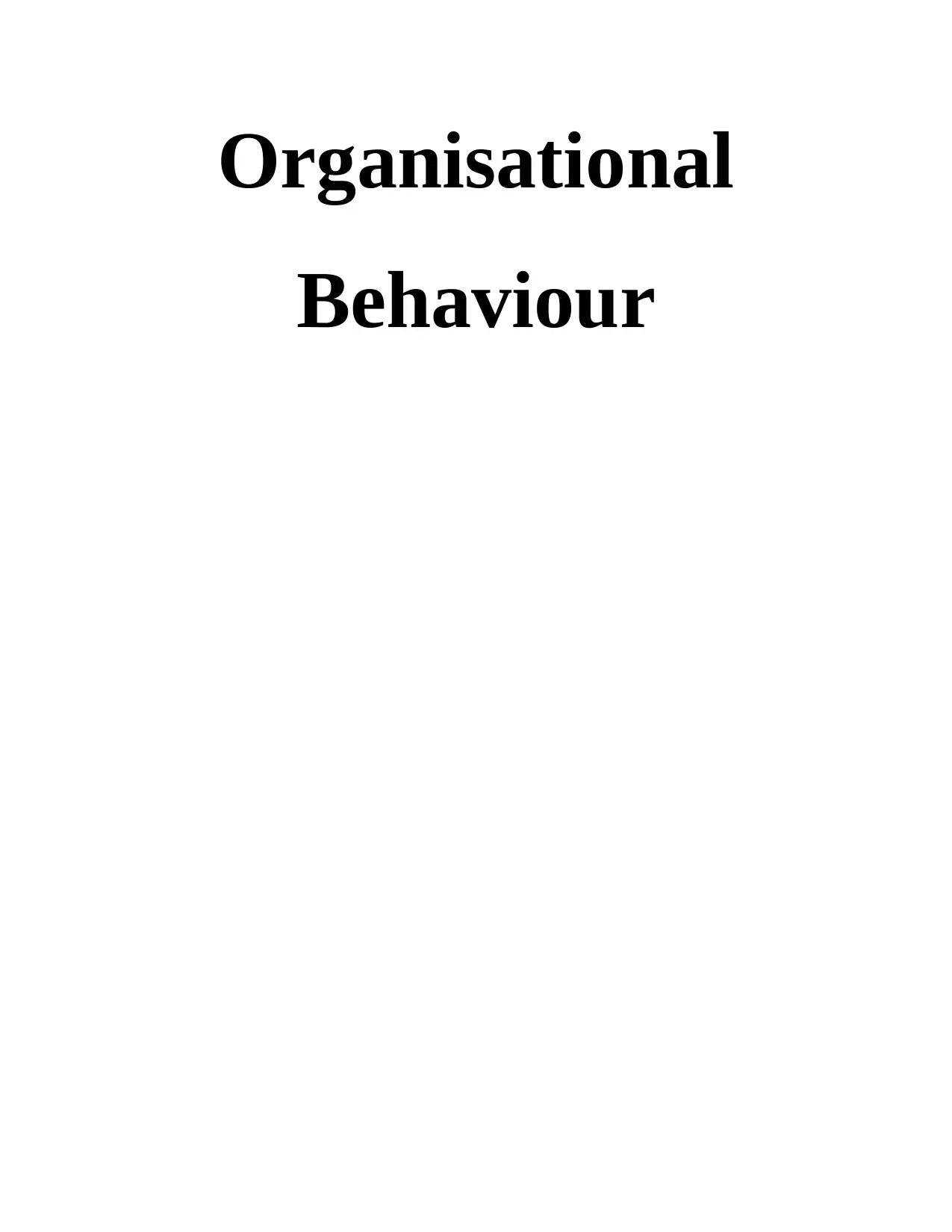
Organisational
Behaviour
Behaviour
Paraphrase This Document
Need a fresh take? Get an instant paraphrase of this document with our AI Paraphraser
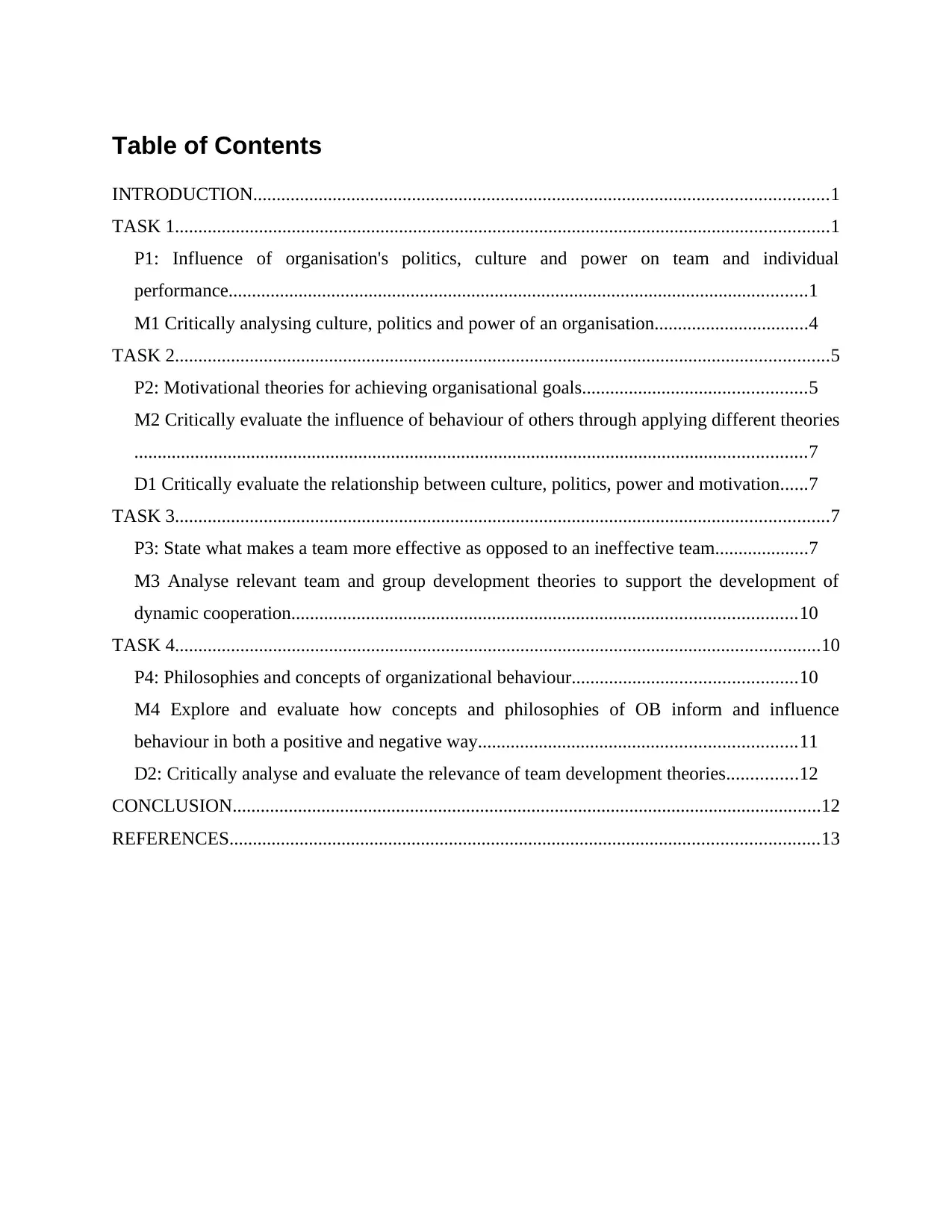
Table of Contents
INTRODUCTION...........................................................................................................................1
TASK 1............................................................................................................................................1
P1: Influence of organisation's politics, culture and power on team and individual
performance............................................................................................................................1
M1 Critically analysing culture, politics and power of an organisation.................................4
TASK 2............................................................................................................................................5
P2: Motivational theories for achieving organisational goals................................................5
M2 Critically evaluate the influence of behaviour of others through applying different theories
................................................................................................................................................7
D1 Critically evaluate the relationship between culture, politics, power and motivation......7
TASK 3............................................................................................................................................7
P3: State what makes a team more effective as opposed to an ineffective team....................7
M3 Analyse relevant team and group development theories to support the development of
dynamic cooperation............................................................................................................10
TASK 4..........................................................................................................................................10
P4: Philosophies and concepts of organizational behaviour................................................10
M4 Explore and evaluate how concepts and philosophies of OB inform and influence
behaviour in both a positive and negative way....................................................................11
D2: Critically analyse and evaluate the relevance of team development theories...............12
CONCLUSION..............................................................................................................................12
REFERENCES..............................................................................................................................13
INTRODUCTION...........................................................................................................................1
TASK 1............................................................................................................................................1
P1: Influence of organisation's politics, culture and power on team and individual
performance............................................................................................................................1
M1 Critically analysing culture, politics and power of an organisation.................................4
TASK 2............................................................................................................................................5
P2: Motivational theories for achieving organisational goals................................................5
M2 Critically evaluate the influence of behaviour of others through applying different theories
................................................................................................................................................7
D1 Critically evaluate the relationship between culture, politics, power and motivation......7
TASK 3............................................................................................................................................7
P3: State what makes a team more effective as opposed to an ineffective team....................7
M3 Analyse relevant team and group development theories to support the development of
dynamic cooperation............................................................................................................10
TASK 4..........................................................................................................................................10
P4: Philosophies and concepts of organizational behaviour................................................10
M4 Explore and evaluate how concepts and philosophies of OB inform and influence
behaviour in both a positive and negative way....................................................................11
D2: Critically analyse and evaluate the relevance of team development theories...............12
CONCLUSION..............................................................................................................................12
REFERENCES..............................................................................................................................13
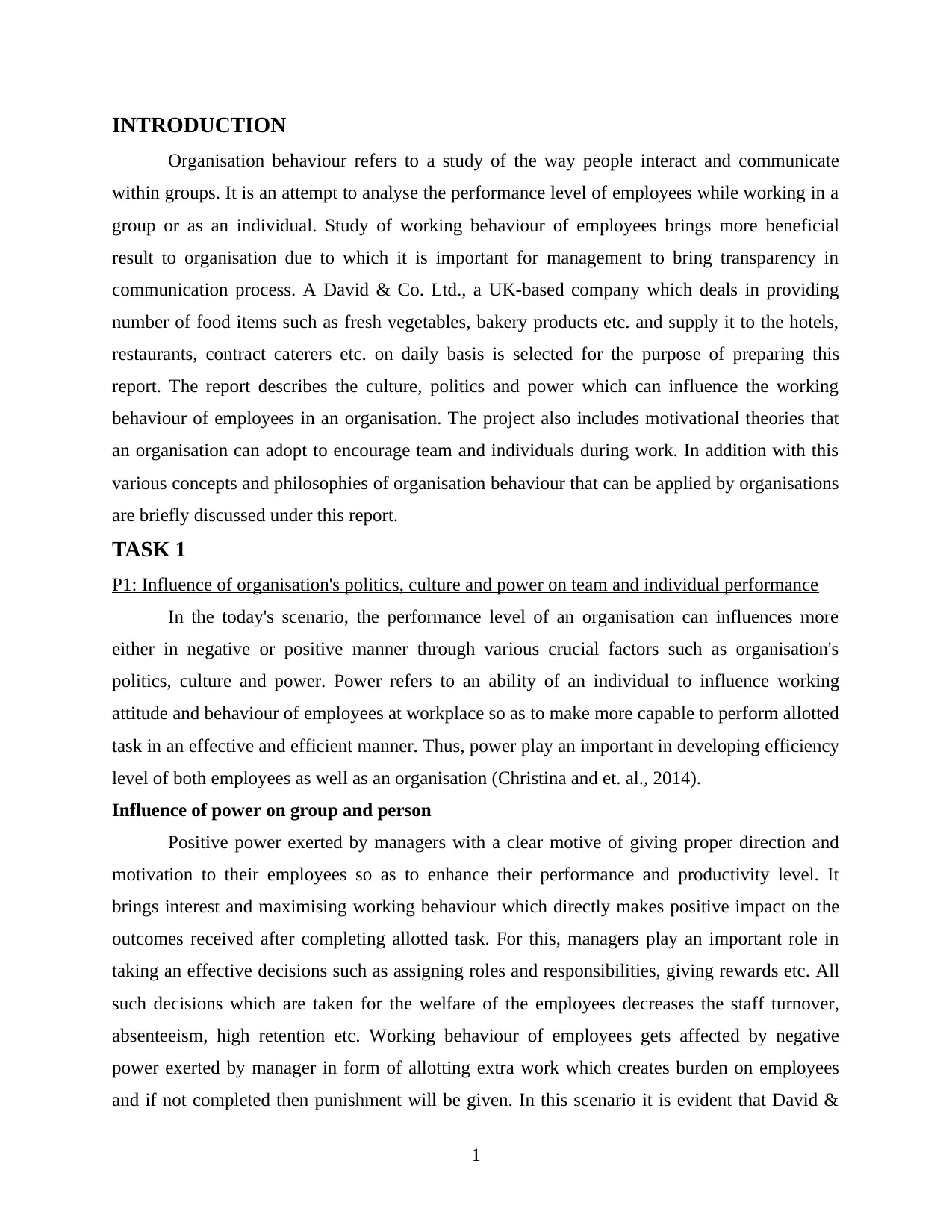
INTRODUCTION
Organisation behaviour refers to a study of the way people interact and communicate
within groups. It is an attempt to analyse the performance level of employees while working in a
group or as an individual. Study of working behaviour of employees brings more beneficial
result to organisation due to which it is important for management to bring transparency in
communication process. A David & Co. Ltd., a UK-based company which deals in providing
number of food items such as fresh vegetables, bakery products etc. and supply it to the hotels,
restaurants, contract caterers etc. on daily basis is selected for the purpose of preparing this
report. The report describes the culture, politics and power which can influence the working
behaviour of employees in an organisation. The project also includes motivational theories that
an organisation can adopt to encourage team and individuals during work. In addition with this
various concepts and philosophies of organisation behaviour that can be applied by organisations
are briefly discussed under this report.
TASK 1
P1: Influence of organisation's politics, culture and power on team and individual performance
In the today's scenario, the performance level of an organisation can influences more
either in negative or positive manner through various crucial factors such as organisation's
politics, culture and power. Power refers to an ability of an individual to influence working
attitude and behaviour of employees at workplace so as to make more capable to perform allotted
task in an effective and efficient manner. Thus, power play an important in developing efficiency
level of both employees as well as an organisation (Christina and et. al., 2014).
Influence of power on group and person
Positive power exerted by managers with a clear motive of giving proper direction and
motivation to their employees so as to enhance their performance and productivity level. It
brings interest and maximising working behaviour which directly makes positive impact on the
outcomes received after completing allotted task. For this, managers play an important role in
taking an effective decisions such as assigning roles and responsibilities, giving rewards etc. All
such decisions which are taken for the welfare of the employees decreases the staff turnover,
absenteeism, high retention etc. Working behaviour of employees gets affected by negative
power exerted by manager in form of allotting extra work which creates burden on employees
and if not completed then punishment will be given. In this scenario it is evident that David &
1
Organisation behaviour refers to a study of the way people interact and communicate
within groups. It is an attempt to analyse the performance level of employees while working in a
group or as an individual. Study of working behaviour of employees brings more beneficial
result to organisation due to which it is important for management to bring transparency in
communication process. A David & Co. Ltd., a UK-based company which deals in providing
number of food items such as fresh vegetables, bakery products etc. and supply it to the hotels,
restaurants, contract caterers etc. on daily basis is selected for the purpose of preparing this
report. The report describes the culture, politics and power which can influence the working
behaviour of employees in an organisation. The project also includes motivational theories that
an organisation can adopt to encourage team and individuals during work. In addition with this
various concepts and philosophies of organisation behaviour that can be applied by organisations
are briefly discussed under this report.
TASK 1
P1: Influence of organisation's politics, culture and power on team and individual performance
In the today's scenario, the performance level of an organisation can influences more
either in negative or positive manner through various crucial factors such as organisation's
politics, culture and power. Power refers to an ability of an individual to influence working
attitude and behaviour of employees at workplace so as to make more capable to perform allotted
task in an effective and efficient manner. Thus, power play an important in developing efficiency
level of both employees as well as an organisation (Christina and et. al., 2014).
Influence of power on group and person
Positive power exerted by managers with a clear motive of giving proper direction and
motivation to their employees so as to enhance their performance and productivity level. It
brings interest and maximising working behaviour which directly makes positive impact on the
outcomes received after completing allotted task. For this, managers play an important role in
taking an effective decisions such as assigning roles and responsibilities, giving rewards etc. All
such decisions which are taken for the welfare of the employees decreases the staff turnover,
absenteeism, high retention etc. Working behaviour of employees gets affected by negative
power exerted by manager in form of allotting extra work which creates burden on employees
and if not completed then punishment will be given. In this scenario it is evident that David &
1
⊘ This is a preview!⊘
Do you want full access?
Subscribe today to unlock all pages.

Trusted by 1+ million students worldwide
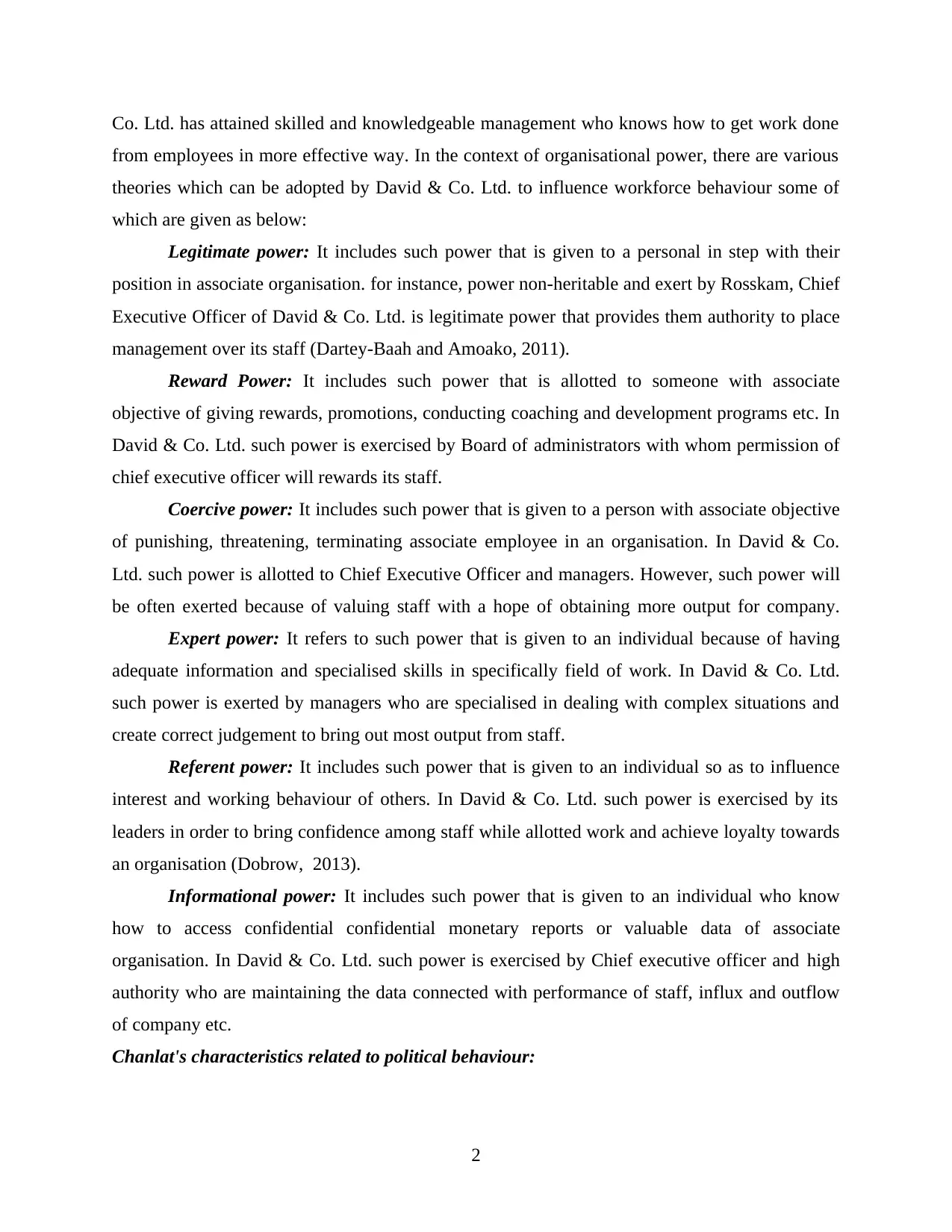
Co. Ltd. has attained skilled and knowledgeable management who knows how to get work done
from employees in more effective way. In the context of organisational power, there are various
theories which can be adopted by David & Co. Ltd. to influence workforce behaviour some of
which are given as below:
Legitimate power: It includes such power that is given to a personal in step with their
position in associate organisation. for instance, power non-heritable and exert by Rosskam, Chief
Executive Officer of David & Co. Ltd. is legitimate power that provides them authority to place
management over its staff (Dartey-Baah and Amoako, 2011).
Reward Power: It includes such power that is allotted to someone with associate
objective of giving rewards, promotions, conducting coaching and development programs etc. In
David & Co. Ltd. such power is exercised by Board of administrators with whom permission of
chief executive officer will rewards its staff.
Coercive power: It includes such power that is given to a person with associate objective
of punishing, threatening, terminating associate employee in an organisation. In David & Co.
Ltd. such power is allotted to Chief Executive Officer and managers. However, such power will
be often exerted because of valuing staff with a hope of obtaining more output for company.
Expert power: It refers to such power that is given to an individual because of having
adequate information and specialised skills in specifically field of work. In David & Co. Ltd.
such power is exerted by managers who are specialised in dealing with complex situations and
create correct judgement to bring out most output from staff.
Referent power: It includes such power that is given to an individual so as to influence
interest and working behaviour of others. In David & Co. Ltd. such power is exercised by its
leaders in order to bring confidence among staff while allotted work and achieve loyalty towards
an organisation (Dobrow, 2013).
Informational power: It includes such power that is given to an individual who know
how to access confidential confidential monetary reports or valuable data of associate
organisation. In David & Co. Ltd. such power is exercised by Chief executive officer and high
authority who are maintaining the data connected with performance of staff, influx and outflow
of company etc.
Chanlat's characteristics related to political behaviour:
2
from employees in more effective way. In the context of organisational power, there are various
theories which can be adopted by David & Co. Ltd. to influence workforce behaviour some of
which are given as below:
Legitimate power: It includes such power that is given to a personal in step with their
position in associate organisation. for instance, power non-heritable and exert by Rosskam, Chief
Executive Officer of David & Co. Ltd. is legitimate power that provides them authority to place
management over its staff (Dartey-Baah and Amoako, 2011).
Reward Power: It includes such power that is allotted to someone with associate
objective of giving rewards, promotions, conducting coaching and development programs etc. In
David & Co. Ltd. such power is exercised by Board of administrators with whom permission of
chief executive officer will rewards its staff.
Coercive power: It includes such power that is given to a person with associate objective
of punishing, threatening, terminating associate employee in an organisation. In David & Co.
Ltd. such power is allotted to Chief Executive Officer and managers. However, such power will
be often exerted because of valuing staff with a hope of obtaining more output for company.
Expert power: It refers to such power that is given to an individual because of having
adequate information and specialised skills in specifically field of work. In David & Co. Ltd.
such power is exerted by managers who are specialised in dealing with complex situations and
create correct judgement to bring out most output from staff.
Referent power: It includes such power that is given to an individual so as to influence
interest and working behaviour of others. In David & Co. Ltd. such power is exercised by its
leaders in order to bring confidence among staff while allotted work and achieve loyalty towards
an organisation (Dobrow, 2013).
Informational power: It includes such power that is given to an individual who know
how to access confidential confidential monetary reports or valuable data of associate
organisation. In David & Co. Ltd. such power is exercised by Chief executive officer and high
authority who are maintaining the data connected with performance of staff, influx and outflow
of company etc.
Chanlat's characteristics related to political behaviour:
2
Paraphrase This Document
Need a fresh take? Get an instant paraphrase of this document with our AI Paraphraser
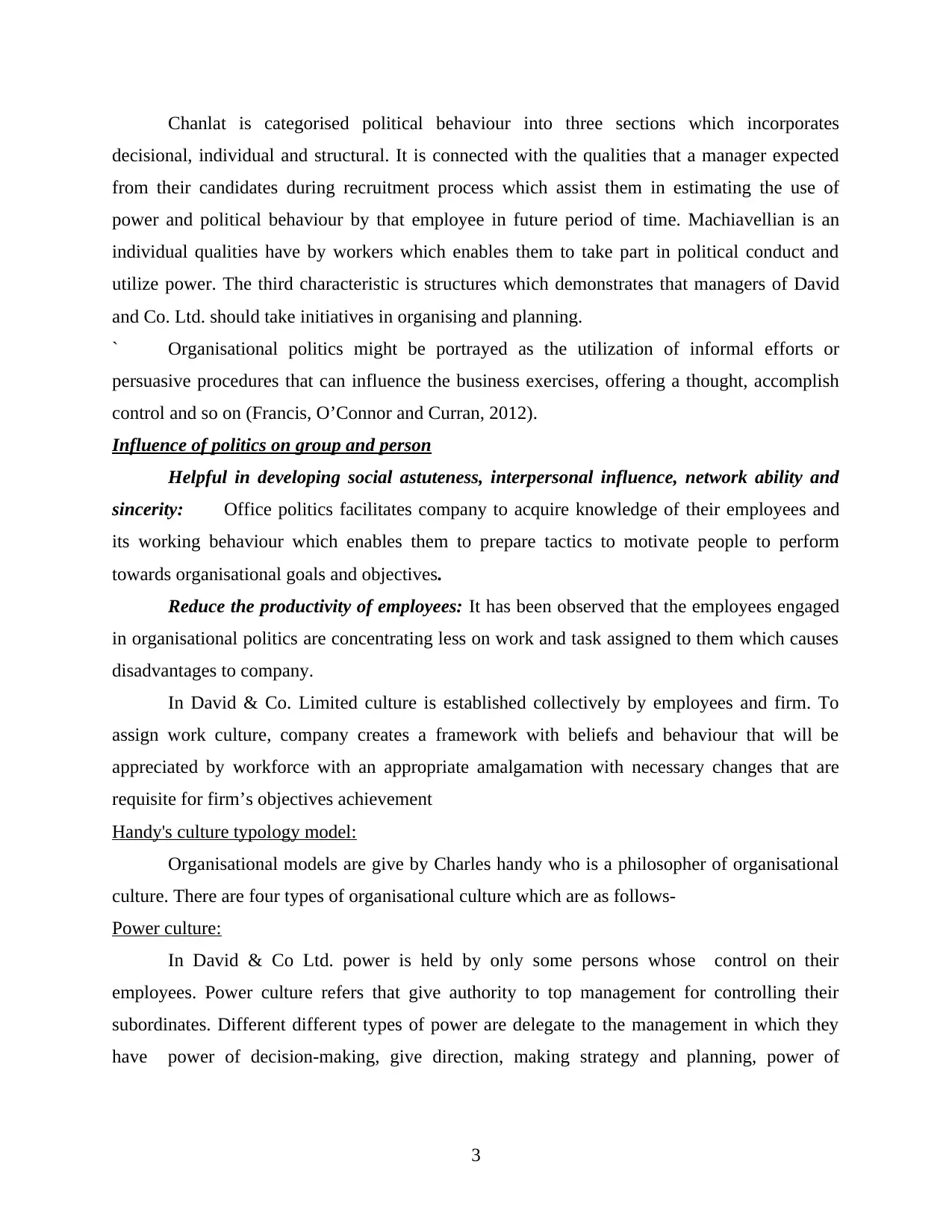
Chanlat is categorised political behaviour into three sections which incorporates
decisional, individual and structural. It is connected with the qualities that a manager expected
from their candidates during recruitment process which assist them in estimating the use of
power and political behaviour by that employee in future period of time. Machiavellian is an
individual qualities have by workers which enables them to take part in political conduct and
utilize power. The third characteristic is structures which demonstrates that managers of David
and Co. Ltd. should take initiatives in organising and planning.
` Organisational politics might be portrayed as the utilization of informal efforts or
persuasive procedures that can influence the business exercises, offering a thought, accomplish
control and so on (Francis, O’Connor and Curran, 2012).
Influence of politics on group and person
Helpful in developing social astuteness, interpersonal influence, network ability and
sincerity: Office politics facilitates company to acquire knowledge of their employees and
its working behaviour which enables them to prepare tactics to motivate people to perform
towards organisational goals and objectives.
Reduce the productivity of employees: It has been observed that the employees engaged
in organisational politics are concentrating less on work and task assigned to them which causes
disadvantages to company.
In David & Co. Limited culture is established collectively by employees and firm. To
assign work culture, company creates a framework with beliefs and behaviour that will be
appreciated by workforce with an appropriate amalgamation with necessary changes that are
requisite for firm’s objectives achievement
Handy's culture typology model:
Organisational models are give by Charles handy who is a philosopher of organisational
culture. There are four types of organisational culture which are as follows-
Power culture:
In David & Co Ltd. power is held by only some persons whose control on their
employees. Power culture refers that give authority to top management for controlling their
subordinates. Different different types of power are delegate to the management in which they
have power of decision-making, give direction, making strategy and planning, power of
3
decisional, individual and structural. It is connected with the qualities that a manager expected
from their candidates during recruitment process which assist them in estimating the use of
power and political behaviour by that employee in future period of time. Machiavellian is an
individual qualities have by workers which enables them to take part in political conduct and
utilize power. The third characteristic is structures which demonstrates that managers of David
and Co. Ltd. should take initiatives in organising and planning.
` Organisational politics might be portrayed as the utilization of informal efforts or
persuasive procedures that can influence the business exercises, offering a thought, accomplish
control and so on (Francis, O’Connor and Curran, 2012).
Influence of politics on group and person
Helpful in developing social astuteness, interpersonal influence, network ability and
sincerity: Office politics facilitates company to acquire knowledge of their employees and
its working behaviour which enables them to prepare tactics to motivate people to perform
towards organisational goals and objectives.
Reduce the productivity of employees: It has been observed that the employees engaged
in organisational politics are concentrating less on work and task assigned to them which causes
disadvantages to company.
In David & Co. Limited culture is established collectively by employees and firm. To
assign work culture, company creates a framework with beliefs and behaviour that will be
appreciated by workforce with an appropriate amalgamation with necessary changes that are
requisite for firm’s objectives achievement
Handy's culture typology model:
Organisational models are give by Charles handy who is a philosopher of organisational
culture. There are four types of organisational culture which are as follows-
Power culture:
In David & Co Ltd. power is held by only some persons whose control on their
employees. Power culture refers that give authority to top management for controlling their
subordinates. Different different types of power are delegate to the management in which they
have power of decision-making, give direction, making strategy and planning, power of
3
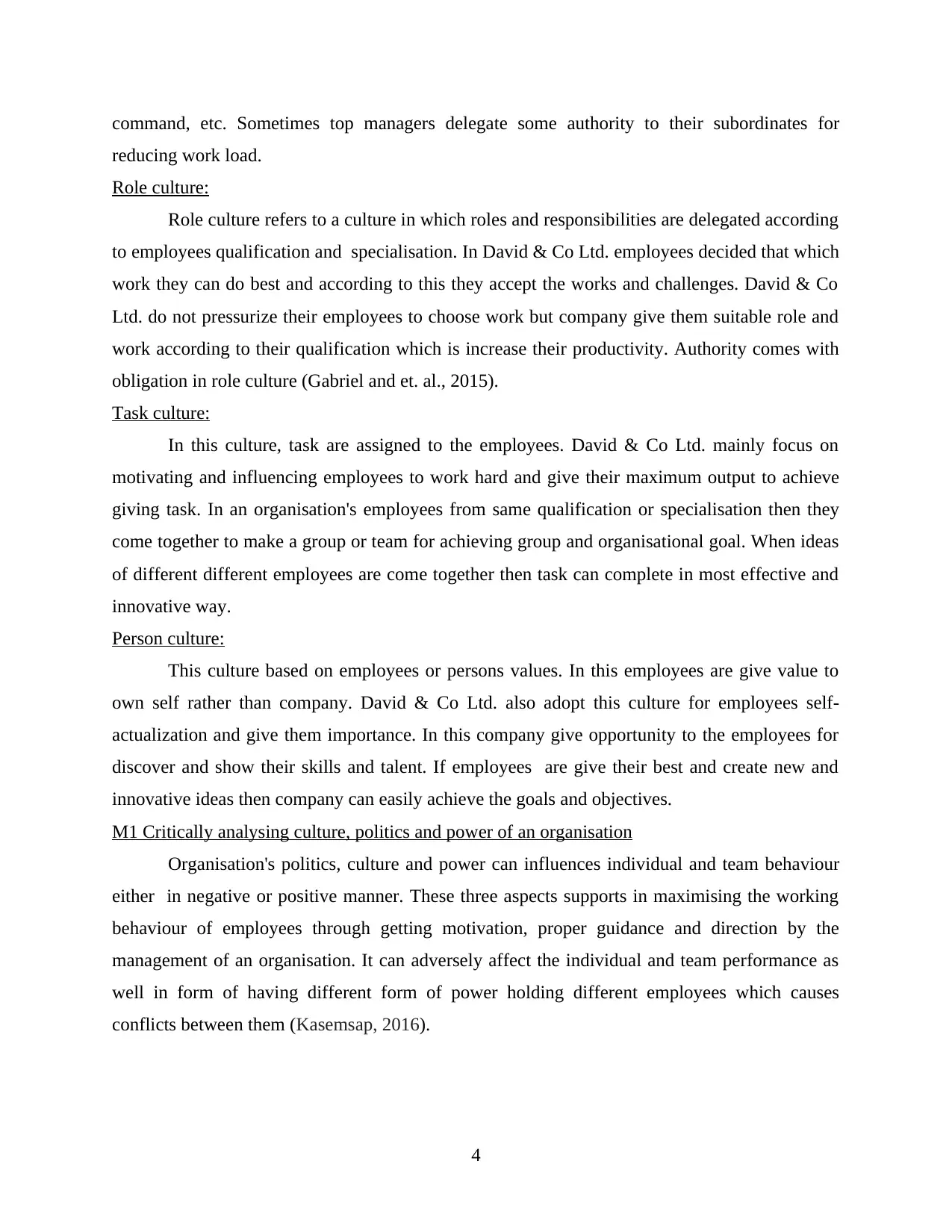
command, etc. Sometimes top managers delegate some authority to their subordinates for
reducing work load.
Role culture:
Role culture refers to a culture in which roles and responsibilities are delegated according
to employees qualification and specialisation. In David & Co Ltd. employees decided that which
work they can do best and according to this they accept the works and challenges. David & Co
Ltd. do not pressurize their employees to choose work but company give them suitable role and
work according to their qualification which is increase their productivity. Authority comes with
obligation in role culture (Gabriel and et. al., 2015).
Task culture:
In this culture, task are assigned to the employees. David & Co Ltd. mainly focus on
motivating and influencing employees to work hard and give their maximum output to achieve
giving task. In an organisation's employees from same qualification or specialisation then they
come together to make a group or team for achieving group and organisational goal. When ideas
of different different employees are come together then task can complete in most effective and
innovative way.
Person culture:
This culture based on employees or persons values. In this employees are give value to
own self rather than company. David & Co Ltd. also adopt this culture for employees self-
actualization and give them importance. In this company give opportunity to the employees for
discover and show their skills and talent. If employees are give their best and create new and
innovative ideas then company can easily achieve the goals and objectives.
M1 Critically analysing culture, politics and power of an organisation
Organisation's politics, culture and power can influences individual and team behaviour
either in negative or positive manner. These three aspects supports in maximising the working
behaviour of employees through getting motivation, proper guidance and direction by the
management of an organisation. It can adversely affect the individual and team performance as
well in form of having different form of power holding different employees which causes
conflicts between them (Kasemsap, 2016).
4
reducing work load.
Role culture:
Role culture refers to a culture in which roles and responsibilities are delegated according
to employees qualification and specialisation. In David & Co Ltd. employees decided that which
work they can do best and according to this they accept the works and challenges. David & Co
Ltd. do not pressurize their employees to choose work but company give them suitable role and
work according to their qualification which is increase their productivity. Authority comes with
obligation in role culture (Gabriel and et. al., 2015).
Task culture:
In this culture, task are assigned to the employees. David & Co Ltd. mainly focus on
motivating and influencing employees to work hard and give their maximum output to achieve
giving task. In an organisation's employees from same qualification or specialisation then they
come together to make a group or team for achieving group and organisational goal. When ideas
of different different employees are come together then task can complete in most effective and
innovative way.
Person culture:
This culture based on employees or persons values. In this employees are give value to
own self rather than company. David & Co Ltd. also adopt this culture for employees self-
actualization and give them importance. In this company give opportunity to the employees for
discover and show their skills and talent. If employees are give their best and create new and
innovative ideas then company can easily achieve the goals and objectives.
M1 Critically analysing culture, politics and power of an organisation
Organisation's politics, culture and power can influences individual and team behaviour
either in negative or positive manner. These three aspects supports in maximising the working
behaviour of employees through getting motivation, proper guidance and direction by the
management of an organisation. It can adversely affect the individual and team performance as
well in form of having different form of power holding different employees which causes
conflicts between them (Kasemsap, 2016).
4
⊘ This is a preview!⊘
Do you want full access?
Subscribe today to unlock all pages.

Trusted by 1+ million students worldwide
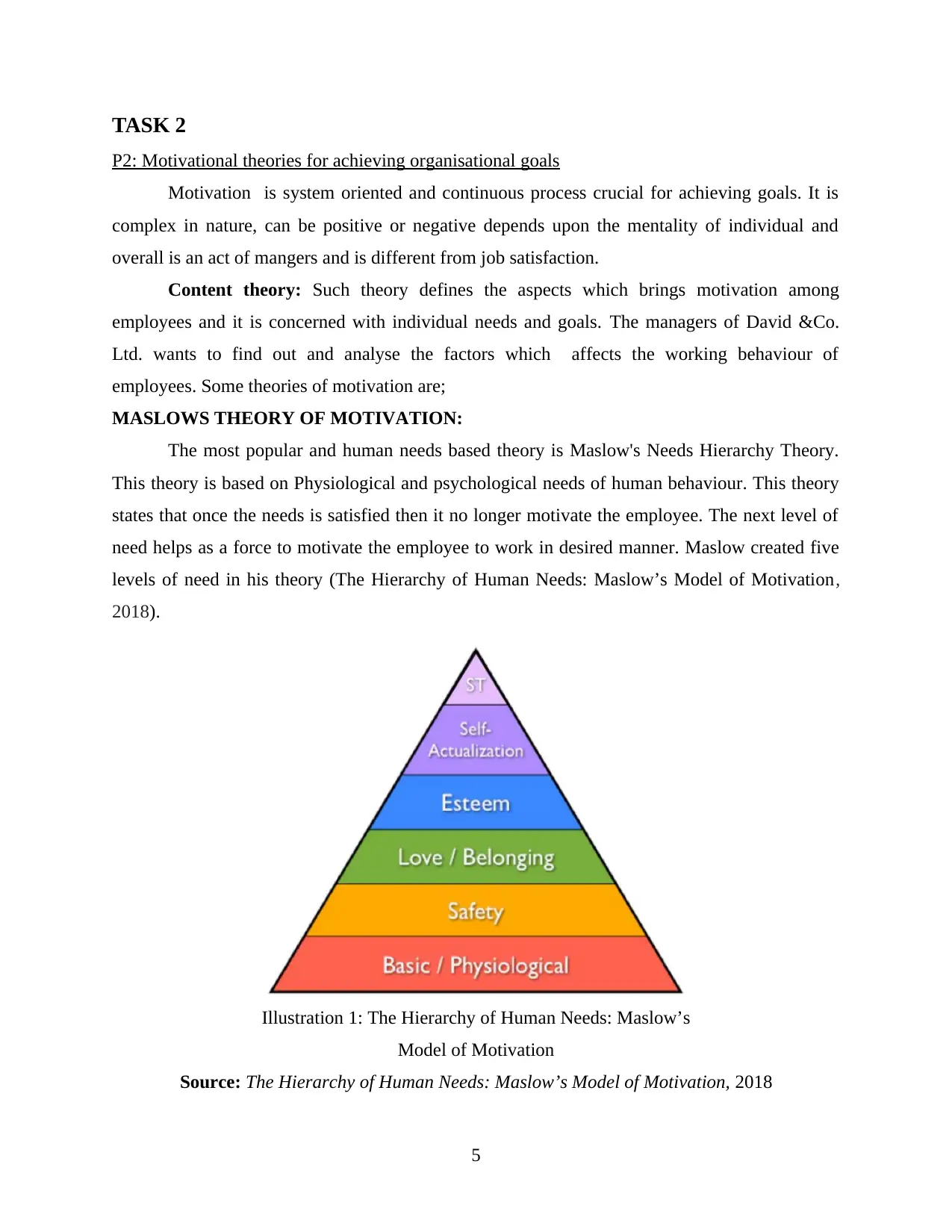
TASK 2
P2: Motivational theories for achieving organisational goals
Motivation is system oriented and continuous process crucial for achieving goals. It is
complex in nature, can be positive or negative depends upon the mentality of individual and
overall is an act of mangers and is different from job satisfaction.
Content theory: Such theory defines the aspects which brings motivation among
employees and it is concerned with individual needs and goals. The managers of David &Co.
Ltd. wants to find out and analyse the factors which affects the working behaviour of
employees. Some theories of motivation are;
MASLOWS THEORY OF MOTIVATION:
The most popular and human needs based theory is Maslow's Needs Hierarchy Theory.
This theory is based on Physiological and psychological needs of human behaviour. This theory
states that once the needs is satisfied then it no longer motivate the employee. The next level of
need helps as a force to motivate the employee to work in desired manner. Maslow created five
levels of need in his theory (The Hierarchy of Human Needs: Maslow’s Model of Motivation,
2018).
Source: The Hierarchy of Human Needs: Maslow’s Model of Motivation, 2018
5
Illustration 1: The Hierarchy of Human Needs: Maslow’s
Model of Motivation
P2: Motivational theories for achieving organisational goals
Motivation is system oriented and continuous process crucial for achieving goals. It is
complex in nature, can be positive or negative depends upon the mentality of individual and
overall is an act of mangers and is different from job satisfaction.
Content theory: Such theory defines the aspects which brings motivation among
employees and it is concerned with individual needs and goals. The managers of David &Co.
Ltd. wants to find out and analyse the factors which affects the working behaviour of
employees. Some theories of motivation are;
MASLOWS THEORY OF MOTIVATION:
The most popular and human needs based theory is Maslow's Needs Hierarchy Theory.
This theory is based on Physiological and psychological needs of human behaviour. This theory
states that once the needs is satisfied then it no longer motivate the employee. The next level of
need helps as a force to motivate the employee to work in desired manner. Maslow created five
levels of need in his theory (The Hierarchy of Human Needs: Maslow’s Model of Motivation,
2018).
Source: The Hierarchy of Human Needs: Maslow’s Model of Motivation, 2018
5
Illustration 1: The Hierarchy of Human Needs: Maslow’s
Model of Motivation
Paraphrase This Document
Need a fresh take? Get an instant paraphrase of this document with our AI Paraphraser
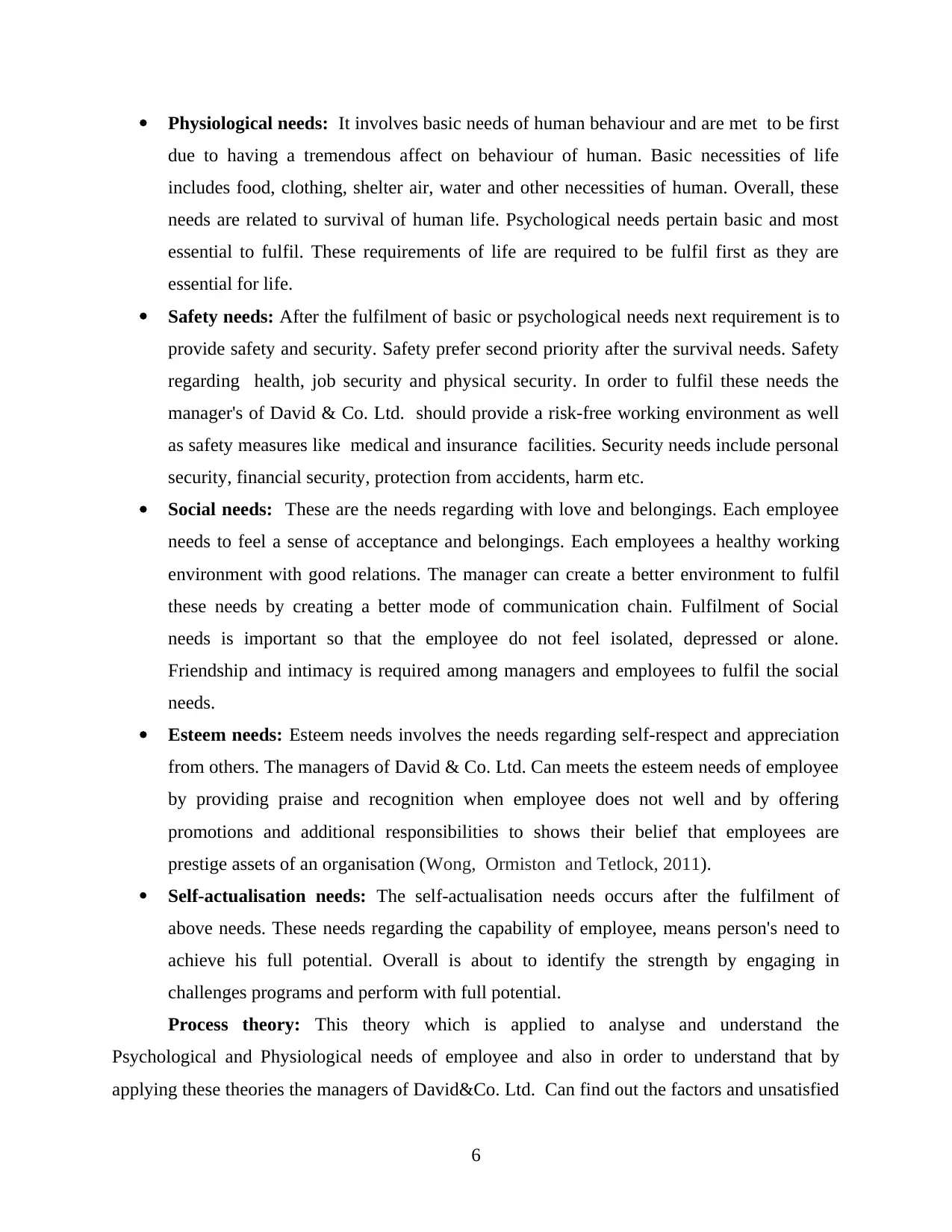
Physiological needs: It involves basic needs of human behaviour and are met to be first
due to having a tremendous affect on behaviour of human. Basic necessities of life
includes food, clothing, shelter air, water and other necessities of human. Overall, these
needs are related to survival of human life. Psychological needs pertain basic and most
essential to fulfil. These requirements of life are required to be fulfil first as they are
essential for life.
Safety needs: After the fulfilment of basic or psychological needs next requirement is to
provide safety and security. Safety prefer second priority after the survival needs. Safety
regarding health, job security and physical security. In order to fulfil these needs the
manager's of David & Co. Ltd. should provide a risk-free working environment as well
as safety measures like medical and insurance facilities. Security needs include personal
security, financial security, protection from accidents, harm etc.
Social needs: These are the needs regarding with love and belongings. Each employee
needs to feel a sense of acceptance and belongings. Each employees a healthy working
environment with good relations. The manager can create a better environment to fulfil
these needs by creating a better mode of communication chain. Fulfilment of Social
needs is important so that the employee do not feel isolated, depressed or alone.
Friendship and intimacy is required among managers and employees to fulfil the social
needs.
Esteem needs: Esteem needs involves the needs regarding self-respect and appreciation
from others. The managers of David & Co. Ltd. Can meets the esteem needs of employee
by providing praise and recognition when employee does not well and by offering
promotions and additional responsibilities to shows their belief that employees are
prestige assets of an organisation (Wong, Ormiston and Tetlock, 2011).
Self-actualisation needs: The self-actualisation needs occurs after the fulfilment of
above needs. These needs regarding the capability of employee, means person's need to
achieve his full potential. Overall is about to identify the strength by engaging in
challenges programs and perform with full potential.
Process theory: This theory which is applied to analyse and understand the
Psychological and Physiological needs of employee and also in order to understand that by
applying these theories the managers of David&Co. Ltd. Can find out the factors and unsatisfied
6
due to having a tremendous affect on behaviour of human. Basic necessities of life
includes food, clothing, shelter air, water and other necessities of human. Overall, these
needs are related to survival of human life. Psychological needs pertain basic and most
essential to fulfil. These requirements of life are required to be fulfil first as they are
essential for life.
Safety needs: After the fulfilment of basic or psychological needs next requirement is to
provide safety and security. Safety prefer second priority after the survival needs. Safety
regarding health, job security and physical security. In order to fulfil these needs the
manager's of David & Co. Ltd. should provide a risk-free working environment as well
as safety measures like medical and insurance facilities. Security needs include personal
security, financial security, protection from accidents, harm etc.
Social needs: These are the needs regarding with love and belongings. Each employee
needs to feel a sense of acceptance and belongings. Each employees a healthy working
environment with good relations. The manager can create a better environment to fulfil
these needs by creating a better mode of communication chain. Fulfilment of Social
needs is important so that the employee do not feel isolated, depressed or alone.
Friendship and intimacy is required among managers and employees to fulfil the social
needs.
Esteem needs: Esteem needs involves the needs regarding self-respect and appreciation
from others. The managers of David & Co. Ltd. Can meets the esteem needs of employee
by providing praise and recognition when employee does not well and by offering
promotions and additional responsibilities to shows their belief that employees are
prestige assets of an organisation (Wong, Ormiston and Tetlock, 2011).
Self-actualisation needs: The self-actualisation needs occurs after the fulfilment of
above needs. These needs regarding the capability of employee, means person's need to
achieve his full potential. Overall is about to identify the strength by engaging in
challenges programs and perform with full potential.
Process theory: This theory which is applied to analyse and understand the
Psychological and Physiological needs of employee and also in order to understand that by
applying these theories the managers of David&Co. Ltd. Can find out the factors and unsatisfied
6
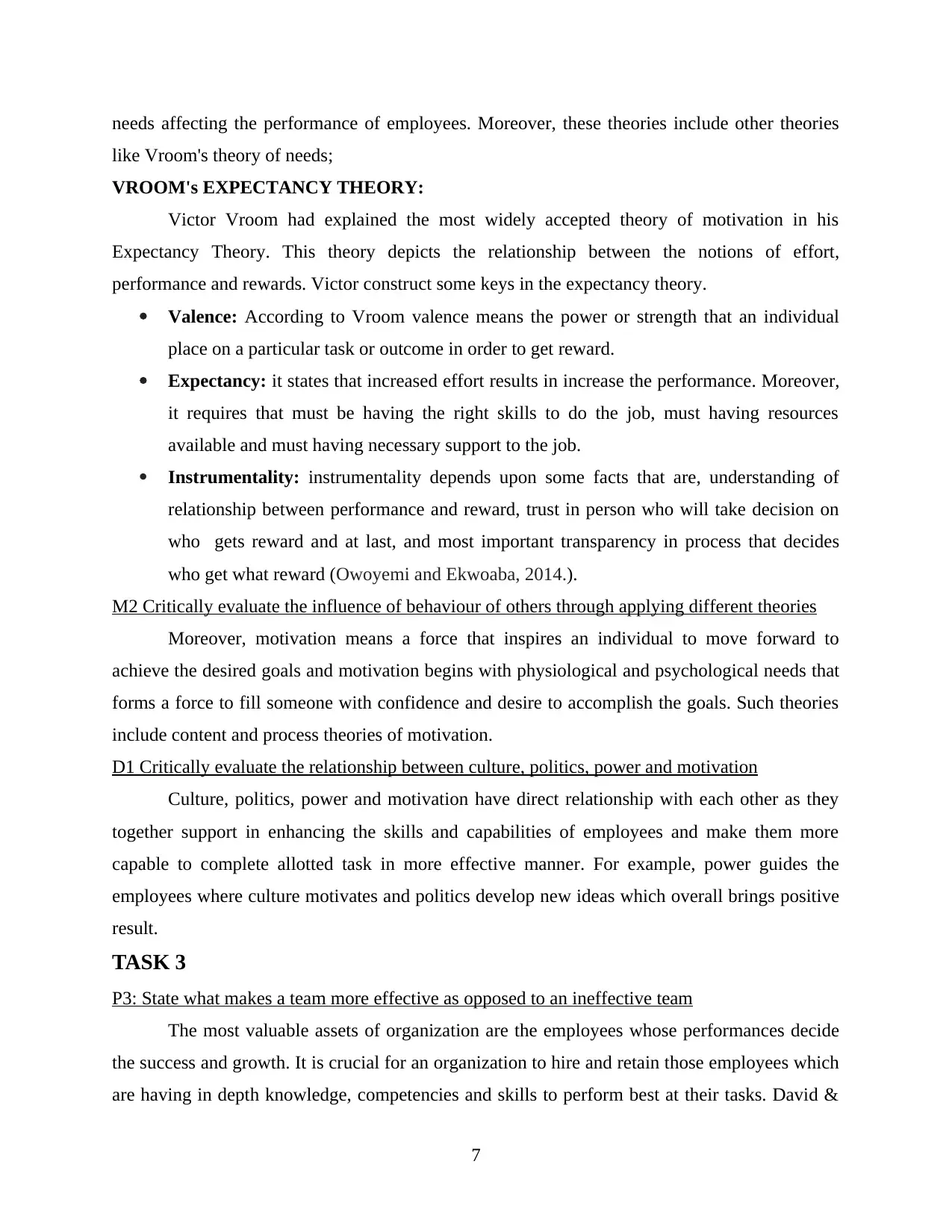
needs affecting the performance of employees. Moreover, these theories include other theories
like Vroom's theory of needs;
VROOM's EXPECTANCY THEORY:
Victor Vroom had explained the most widely accepted theory of motivation in his
Expectancy Theory. This theory depicts the relationship between the notions of effort,
performance and rewards. Victor construct some keys in the expectancy theory.
Valence: According to Vroom valence means the power or strength that an individual
place on a particular task or outcome in order to get reward.
Expectancy: it states that increased effort results in increase the performance. Moreover,
it requires that must be having the right skills to do the job, must having resources
available and must having necessary support to the job.
Instrumentality: instrumentality depends upon some facts that are, understanding of
relationship between performance and reward, trust in person who will take decision on
who gets reward and at last, and most important transparency in process that decides
who get what reward (Owoyemi and Ekwoaba, 2014.).
M2 Critically evaluate the influence of behaviour of others through applying different theories
Moreover, motivation means a force that inspires an individual to move forward to
achieve the desired goals and motivation begins with physiological and psychological needs that
forms a force to fill someone with confidence and desire to accomplish the goals. Such theories
include content and process theories of motivation.
D1 Critically evaluate the relationship between culture, politics, power and motivation
Culture, politics, power and motivation have direct relationship with each other as they
together support in enhancing the skills and capabilities of employees and make them more
capable to complete allotted task in more effective manner. For example, power guides the
employees where culture motivates and politics develop new ideas which overall brings positive
result.
TASK 3
P3: State what makes a team more effective as opposed to an ineffective team
The most valuable assets of organization are the employees whose performances decide
the success and growth. It is crucial for an organization to hire and retain those employees which
are having in depth knowledge, competencies and skills to perform best at their tasks. David &
7
like Vroom's theory of needs;
VROOM's EXPECTANCY THEORY:
Victor Vroom had explained the most widely accepted theory of motivation in his
Expectancy Theory. This theory depicts the relationship between the notions of effort,
performance and rewards. Victor construct some keys in the expectancy theory.
Valence: According to Vroom valence means the power or strength that an individual
place on a particular task or outcome in order to get reward.
Expectancy: it states that increased effort results in increase the performance. Moreover,
it requires that must be having the right skills to do the job, must having resources
available and must having necessary support to the job.
Instrumentality: instrumentality depends upon some facts that are, understanding of
relationship between performance and reward, trust in person who will take decision on
who gets reward and at last, and most important transparency in process that decides
who get what reward (Owoyemi and Ekwoaba, 2014.).
M2 Critically evaluate the influence of behaviour of others through applying different theories
Moreover, motivation means a force that inspires an individual to move forward to
achieve the desired goals and motivation begins with physiological and psychological needs that
forms a force to fill someone with confidence and desire to accomplish the goals. Such theories
include content and process theories of motivation.
D1 Critically evaluate the relationship between culture, politics, power and motivation
Culture, politics, power and motivation have direct relationship with each other as they
together support in enhancing the skills and capabilities of employees and make them more
capable to complete allotted task in more effective manner. For example, power guides the
employees where culture motivates and politics develop new ideas which overall brings positive
result.
TASK 3
P3: State what makes a team more effective as opposed to an ineffective team
The most valuable assets of organization are the employees whose performances decide
the success and growth. It is crucial for an organization to hire and retain those employees which
are having in depth knowledge, competencies and skills to perform best at their tasks. David &
7
⊘ This is a preview!⊘
Do you want full access?
Subscribe today to unlock all pages.

Trusted by 1+ million students worldwide
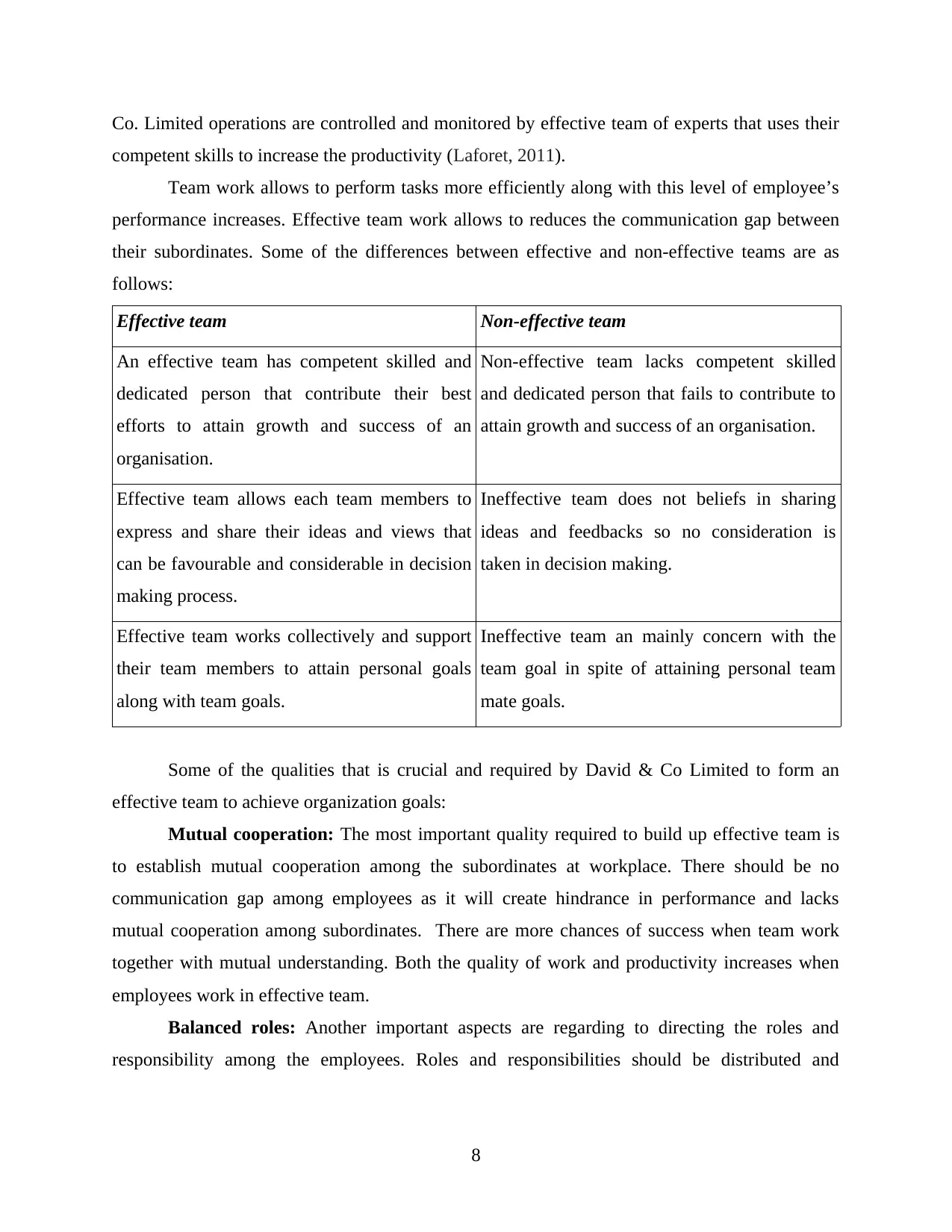
Co. Limited operations are controlled and monitored by effective team of experts that uses their
competent skills to increase the productivity (Laforet, 2011).
Team work allows to perform tasks more efficiently along with this level of employee’s
performance increases. Effective team work allows to reduces the communication gap between
their subordinates. Some of the differences between effective and non-effective teams are as
follows:
Effective team Non-effective team
An effective team has competent skilled and
dedicated person that contribute their best
efforts to attain growth and success of an
organisation.
Non-effective team lacks competent skilled
and dedicated person that fails to contribute to
attain growth and success of an organisation.
Effective team allows each team members to
express and share their ideas and views that
can be favourable and considerable in decision
making process.
Ineffective team does not beliefs in sharing
ideas and feedbacks so no consideration is
taken in decision making.
Effective team works collectively and support
their team members to attain personal goals
along with team goals.
Ineffective team an mainly concern with the
team goal in spite of attaining personal team
mate goals.
Some of the qualities that is crucial and required by David & Co Limited to form an
effective team to achieve organization goals:
Mutual cooperation: The most important quality required to build up effective team is
to establish mutual cooperation among the subordinates at workplace. There should be no
communication gap among employees as it will create hindrance in performance and lacks
mutual cooperation among subordinates. There are more chances of success when team work
together with mutual understanding. Both the quality of work and productivity increases when
employees work in effective team.
Balanced roles: Another important aspects are regarding to directing the roles and
responsibility among the employees. Roles and responsibilities should be distributed and
8
competent skills to increase the productivity (Laforet, 2011).
Team work allows to perform tasks more efficiently along with this level of employee’s
performance increases. Effective team work allows to reduces the communication gap between
their subordinates. Some of the differences between effective and non-effective teams are as
follows:
Effective team Non-effective team
An effective team has competent skilled and
dedicated person that contribute their best
efforts to attain growth and success of an
organisation.
Non-effective team lacks competent skilled
and dedicated person that fails to contribute to
attain growth and success of an organisation.
Effective team allows each team members to
express and share their ideas and views that
can be favourable and considerable in decision
making process.
Ineffective team does not beliefs in sharing
ideas and feedbacks so no consideration is
taken in decision making.
Effective team works collectively and support
their team members to attain personal goals
along with team goals.
Ineffective team an mainly concern with the
team goal in spite of attaining personal team
mate goals.
Some of the qualities that is crucial and required by David & Co Limited to form an
effective team to achieve organization goals:
Mutual cooperation: The most important quality required to build up effective team is
to establish mutual cooperation among the subordinates at workplace. There should be no
communication gap among employees as it will create hindrance in performance and lacks
mutual cooperation among subordinates. There are more chances of success when team work
together with mutual understanding. Both the quality of work and productivity increases when
employees work in effective team.
Balanced roles: Another important aspects are regarding to directing the roles and
responsibility among the employees. Roles and responsibilities should be distributed and
8
Paraphrase This Document
Need a fresh take? Get an instant paraphrase of this document with our AI Paraphraser
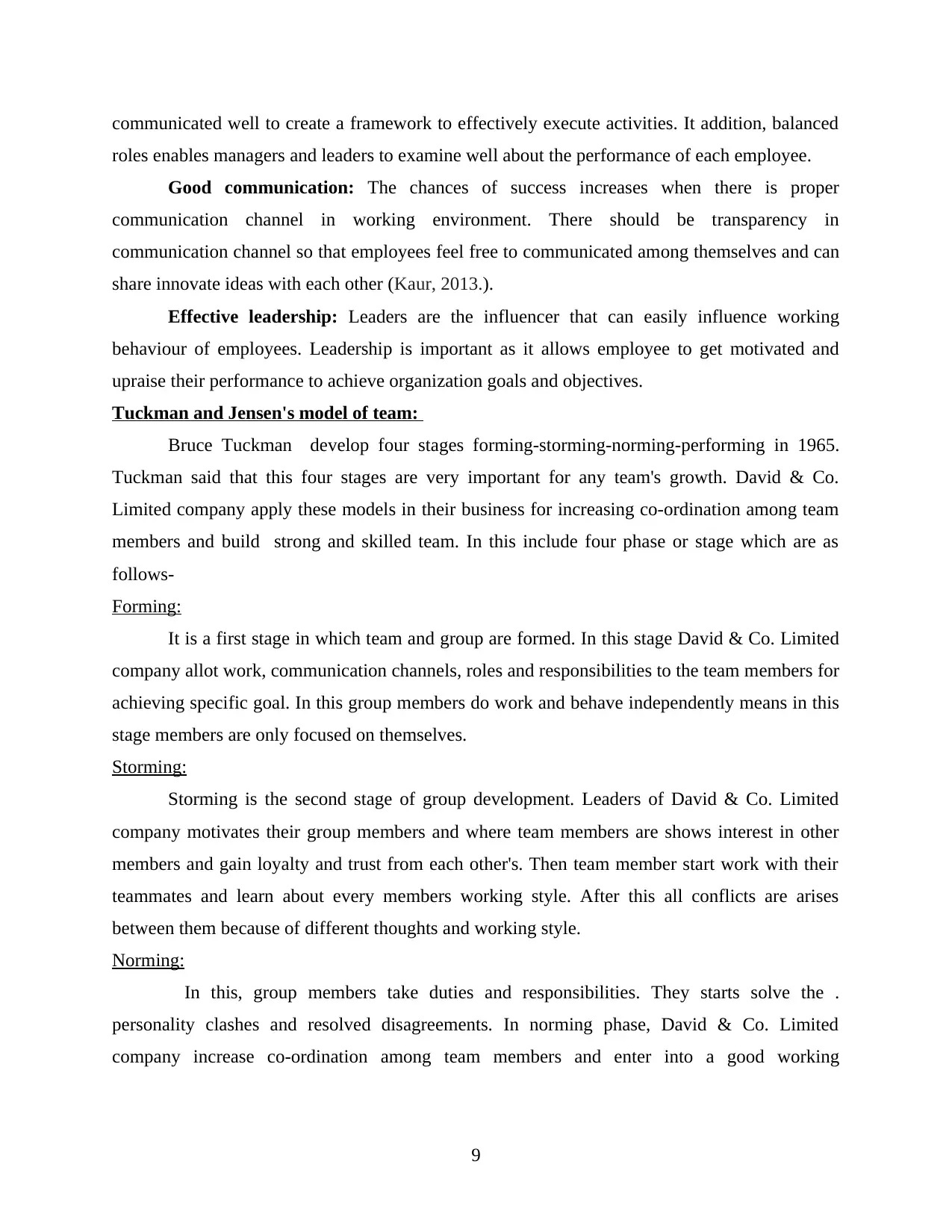
communicated well to create a framework to effectively execute activities. It addition, balanced
roles enables managers and leaders to examine well about the performance of each employee.
Good communication: The chances of success increases when there is proper
communication channel in working environment. There should be transparency in
communication channel so that employees feel free to communicated among themselves and can
share innovate ideas with each other (Kaur, 2013.).
Effective leadership: Leaders are the influencer that can easily influence working
behaviour of employees. Leadership is important as it allows employee to get motivated and
upraise their performance to achieve organization goals and objectives.
Tuckman and Jensen's model of team:
Bruce Tuckman develop four stages forming-storming-norming-performing in 1965.
Tuckman said that this four stages are very important for any team's growth. David & Co.
Limited company apply these models in their business for increasing co-ordination among team
members and build strong and skilled team. In this include four phase or stage which are as
follows-
Forming:
It is a first stage in which team and group are formed. In this stage David & Co. Limited
company allot work, communication channels, roles and responsibilities to the team members for
achieving specific goal. In this group members do work and behave independently means in this
stage members are only focused on themselves.
Storming:
Storming is the second stage of group development. Leaders of David & Co. Limited
company motivates their group members and where team members are shows interest in other
members and gain loyalty and trust from each other's. Then team member start work with their
teammates and learn about every members working style. After this all conflicts are arises
between them because of different thoughts and working style.
Norming:
In this, group members take duties and responsibilities. They starts solve the .
personality clashes and resolved disagreements. In norming phase, David & Co. Limited
company increase co-ordination among team members and enter into a good working
9
roles enables managers and leaders to examine well about the performance of each employee.
Good communication: The chances of success increases when there is proper
communication channel in working environment. There should be transparency in
communication channel so that employees feel free to communicated among themselves and can
share innovate ideas with each other (Kaur, 2013.).
Effective leadership: Leaders are the influencer that can easily influence working
behaviour of employees. Leadership is important as it allows employee to get motivated and
upraise their performance to achieve organization goals and objectives.
Tuckman and Jensen's model of team:
Bruce Tuckman develop four stages forming-storming-norming-performing in 1965.
Tuckman said that this four stages are very important for any team's growth. David & Co.
Limited company apply these models in their business for increasing co-ordination among team
members and build strong and skilled team. In this include four phase or stage which are as
follows-
Forming:
It is a first stage in which team and group are formed. In this stage David & Co. Limited
company allot work, communication channels, roles and responsibilities to the team members for
achieving specific goal. In this group members do work and behave independently means in this
stage members are only focused on themselves.
Storming:
Storming is the second stage of group development. Leaders of David & Co. Limited
company motivates their group members and where team members are shows interest in other
members and gain loyalty and trust from each other's. Then team member start work with their
teammates and learn about every members working style. After this all conflicts are arises
between them because of different thoughts and working style.
Norming:
In this, group members take duties and responsibilities. They starts solve the .
personality clashes and resolved disagreements. In norming phase, David & Co. Limited
company increase co-ordination among team members and enter into a good working
9
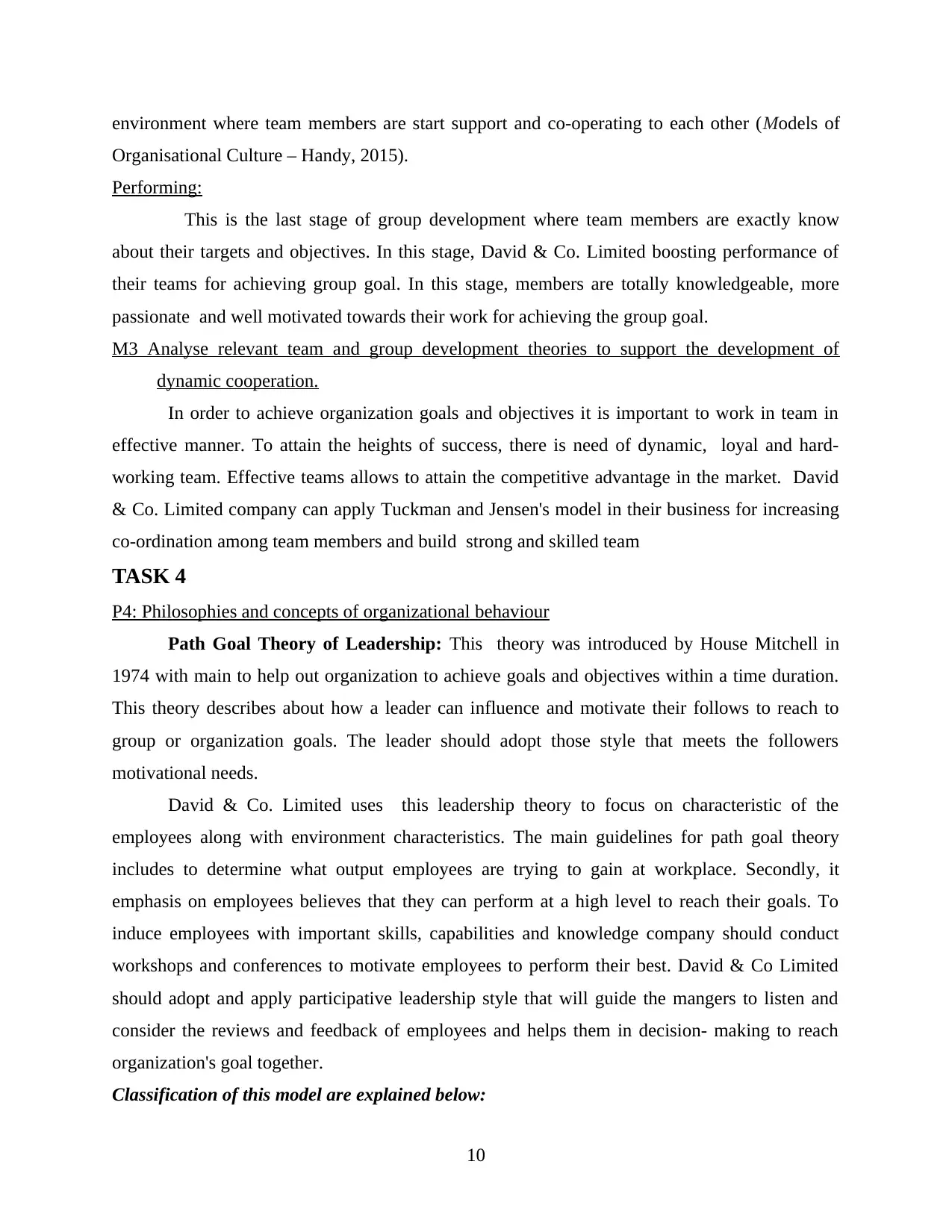
environment where team members are start support and co-operating to each other (Models of
Organisational Culture – Handy, 2015).
Performing:
This is the last stage of group development where team members are exactly know
about their targets and objectives. In this stage, David & Co. Limited boosting performance of
their teams for achieving group goal. In this stage, members are totally knowledgeable, more
passionate and well motivated towards their work for achieving the group goal.
M3 Analyse relevant team and group development theories to support the development of
dynamic cooperation.
In order to achieve organization goals and objectives it is important to work in team in
effective manner. To attain the heights of success, there is need of dynamic, loyal and hard-
working team. Effective teams allows to attain the competitive advantage in the market. David
& Co. Limited company can apply Tuckman and Jensen's model in their business for increasing
co-ordination among team members and build strong and skilled team
TASK 4
P4: Philosophies and concepts of organizational behaviour
Path Goal Theory of Leadership: This theory was introduced by House Mitchell in
1974 with main to help out organization to achieve goals and objectives within a time duration.
This theory describes about how a leader can influence and motivate their follows to reach to
group or organization goals. The leader should adopt those style that meets the followers
motivational needs.
David & Co. Limited uses this leadership theory to focus on characteristic of the
employees along with environment characteristics. The main guidelines for path goal theory
includes to determine what output employees are trying to gain at workplace. Secondly, it
emphasis on employees believes that they can perform at a high level to reach their goals. To
induce employees with important skills, capabilities and knowledge company should conduct
workshops and conferences to motivate employees to perform their best. David & Co Limited
should adopt and apply participative leadership style that will guide the mangers to listen and
consider the reviews and feedback of employees and helps them in decision- making to reach
organization's goal together.
Classification of this model are explained below:
10
Organisational Culture – Handy, 2015).
Performing:
This is the last stage of group development where team members are exactly know
about their targets and objectives. In this stage, David & Co. Limited boosting performance of
their teams for achieving group goal. In this stage, members are totally knowledgeable, more
passionate and well motivated towards their work for achieving the group goal.
M3 Analyse relevant team and group development theories to support the development of
dynamic cooperation.
In order to achieve organization goals and objectives it is important to work in team in
effective manner. To attain the heights of success, there is need of dynamic, loyal and hard-
working team. Effective teams allows to attain the competitive advantage in the market. David
& Co. Limited company can apply Tuckman and Jensen's model in their business for increasing
co-ordination among team members and build strong and skilled team
TASK 4
P4: Philosophies and concepts of organizational behaviour
Path Goal Theory of Leadership: This theory was introduced by House Mitchell in
1974 with main to help out organization to achieve goals and objectives within a time duration.
This theory describes about how a leader can influence and motivate their follows to reach to
group or organization goals. The leader should adopt those style that meets the followers
motivational needs.
David & Co. Limited uses this leadership theory to focus on characteristic of the
employees along with environment characteristics. The main guidelines for path goal theory
includes to determine what output employees are trying to gain at workplace. Secondly, it
emphasis on employees believes that they can perform at a high level to reach their goals. To
induce employees with important skills, capabilities and knowledge company should conduct
workshops and conferences to motivate employees to perform their best. David & Co Limited
should adopt and apply participative leadership style that will guide the mangers to listen and
consider the reviews and feedback of employees and helps them in decision- making to reach
organization's goal together.
Classification of this model are explained below:
10
⊘ This is a preview!⊘
Do you want full access?
Subscribe today to unlock all pages.

Trusted by 1+ million students worldwide
1 out of 17
Related Documents
Your All-in-One AI-Powered Toolkit for Academic Success.
+13062052269
info@desklib.com
Available 24*7 on WhatsApp / Email
![[object Object]](/_next/static/media/star-bottom.7253800d.svg)
Unlock your academic potential
Copyright © 2020–2025 A2Z Services. All Rights Reserved. Developed and managed by ZUCOL.




